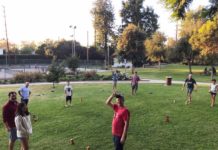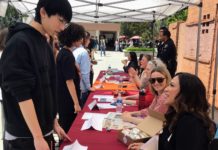
The South Pasadena Public Safety Commission had its first meeting in four weeks Monday morning, with commissioners participating remotely from their homes via teleconference while mask-clad fire and police chiefs gave reports from inside the City Council’s meeting chamber.
One notable piece of information is that while both fire and police calls were down 30 percent at the outset of the COVID-19 crisis, fire calls have climbed almost all the way back while police calls have fallen further to 60 percent below normal. Suspected COVID-19 cases dominate fire department transports, while the police say the stay-at-home order is depressing crime.
Report from Fire Chief Paul Riddle:
Riddle said the city’s recently remodeled Emergency Operations Center opened March 18 after the City Council approved its local emergency proclamation. Overseen by Division Chief Eric Zanteson, the EOC continues to operate at its lowest pitch, Level 3, not requiring 24/7 staffing but facilitating expense tracking and coordination of federal and state pandemic-related reimbursement for the city’s response and recovery efforts.
The County’s extension of the safer-at-home orders to May 15 required all essential workers to wear face covers as of that day, while members of the public must wear at least a cloth face covering any time they engage with others in a public or private setting, when obtaining essential services or in a public setting around others.
Washing hands remains the critical strategy to flatten the curve. Riddle said a surgical mask would be an enhancement–to ensure supplies for medical workers and first responders, their use is not being promoted.
Riddle said there is some “grey area” in the state and county guidance about when to wear a mask, but the rule of thumb is: when in doubt, wear one. Technically, masks are not required if one is out exercising, walking with a member of one’s household, or alone with a pet. But in a group or area where a six-foot distance cannot be maintained at all times, a mask is required. “Err on the side of wearing one.”
The fire chief acknowledged the growth in COVID-19 cases in South Pasadena—up to 17 as of April 14–adding he has no details on those cases. Unlike a month ago, there is no state or county projection for hospital bed or ICU bed shortages, and the peak demand was modeled to occur on April 13, with peak daily reported COVID-19 deaths on April 15 (the county reported a record daily total of 40 on Tuesday). He said the county has run 47,000 COVID-19 tests with 14 percent of those coming back positive and 24 percent of the positives requiring hospitalization. The number of testing sites is increasing by the week, and the county has now opened testing to anyone with symptoms or a confirmed exposure.
Some hospitals in the county are saturated while others have much greater availability of beds. Jurisdictions are working to create “dashboards” so all can see where beds are available to transport patients and to optimize the load. Emergency vehicle diversions away from Huntington Hospital to another hospital occur, but at a rate that is now less than before the crisis, the chief reported. “We’re getting better at it and hospitals are communicating well.”
Meantime the fire department remains fully staffed and morale is “very high.” Three new paramedics were brought on just before the crisis hit and while their training was condensed to three weeks, they’re onboard and have been doing “an outstanding job at a difficult time.”
No operational conditions have changed though there are contingency plans in place in case personnel become sick—so far none have, despite having transported “numerous” suspected COVID-19 patients. All time off has been canceled through May 15. The Department’s stockpile of personal protective equipment, now worn on all calls, is sufficient. Facilities and equipment are regularly sanitized.
There is a reserve ambulance in place used exclusively for suspected COVID-19 cases. All mutual aid agreements with 13 nearby cities remain in place and a dashboard allows each to see all calls, aiding the allocation of resources. “All the agencies are lined up. If our units were tied up for whatever reason, our citizens would still be safe,” Riddle said.
The percentage of fire calls remain low, though not as low as earlier in the crisis. Riddle said calls are now down about 10 percent, compared to 30 percent two weeks ago. But there has been an uptick in the percent of COVID-19 patients being transported. Virtually all EMS calls now are suspected cases.
Fire calls are down across the 31 fire departments in the county reporting, he added.
Transports of patients are also down, he said, because the community appears to be complying with advice to phone their primary physicians before making a 911 call when they suspect COVID-19 symptoms. In addition, calls are filtered through a doctor at the dispatch center. Hospitals have largely standardized their COVID-19 admission protocols since the crisis began, triaging patients outside the emergency room and directing suspected COVID cases to one part of the hospital while the rest are admitted to the emergency room.
Report from Police Chief Joe Ortiz:
Chief Ortiz told the Commission that police calls have dropped significantly. As with the Fire department, calls initially dropped 30 percent, but unlike Fire have continued to decrease. Over the past three weeks, calls are down a remarkable 60 percent.
Commissioner Amin Al-Sarraf said he worries the decrease in calls may in part reflect a constrained ability of domestic violence (DV) victims to reach out. The chief said that is quite possible, but regional chiefs believe the principal reason for the reduction is people staying home. Property crimes are still being reported. He said neighbors should be vigilant and call if they sense anything is amiss. “I feel pretty confident that if there was a problem, somebody in some neighborhood would make a phone call.”
“I hope that is true,” Al-Sarraf replied. But he said some effort should be made for DV victims to “allow access to services or police” at still operating essential businesses. Commission Chair Jeremy Ding agreed, saying DV victims “could be being victimized at a higher rate.”
Regardless, the reduction in calls has given officers more time to ensure compliance with social distancing, especially at the golf course and in the city’s parks, Ortiz reported. “We’re contacting 25 to 50 people a day,” though almost 100 contacts were made Easter Sunday at Garfield Park, and a group of runners who jumped a fence at the high school to reach the track were quickly escorted off campus.
While acknowledging alleged violations of social distancing rules are generating quite a few calls, the police are seeing a compliance rate of up to 80 percent, he said. People are responsive when contacted by police. “They get it.” Walking and exercise are still encouraged and so far, no citations for social distance violations have been issued, he said, although in fact one was issued to a local pub owner. The Department hopes to continue relying on public outreach and educating the community as its main enforcement strategy.
The Chief detailed the Department’s ongoing work with senior citizens, the homeless, and the many community groups working to meet the meal delivery, grocery and various other needs of those groups. These include the Holy Family, the DUDES’ 100 grocery delivery volunteers, and the Chinese American PTA group which provided 23,000 masks, 1,500 sets of gloves, 90 bottles of hand sanitizer and 105 sets of protective clothing. Anyone concerned about a senior citizen can request the Department to call on that person, the chief said.
The city’s Homeless Outreach Psychiatric Engagement team continues work to connect the homeless to various resources, however police deployments in association with the Measure H-funded Homeless Outreach Service Team, which concentrates on referrals to housing and rehabilitation, have been cancelled, Ortiz reported without elaboration. He said public bathrooms remain open 24/7 and that housing vouchers are available for the nine homeless persons known to be in town.
Third District City Councilman Richard Schneider, the Commission’s Council liaison, asked Ortiz about the use of Caltrans homes by homeless. The Chief said while they received such reports, they did not find anyone there. The police are willing to follow up such reports, but he said it is CHP’s jurisdiction to ensure people do not illegally occupy those homes. Nor has he heard anything from the state about allowing homeless to move in as part of the pandemic response.
The city’s half dozen detectives, who last week received laptop computers, are now working from home. This means they are not exposed to potential infection at the station and are available to be called up for patrol work if there are any staff shortages due to the virus.
Ortiz said fingerprinting and citation corrections at City Hall have been suspended until further notice since the courts are closed; overnight parking enforcement is suspended through April 30, though that could be extended through May 15.
Vehicles and the police station are cleaned daily, and deep-cleaned every two weeks. Officers have been directed since April 9 to wear face masks when engaging the public.
Besides frequent communication with the fire chief, Ortiz said he is in regular contact with many regional chiefs to compare notes on practices and “what’s coming down the pike.”
Ortiz also confirmed that over the past month there has been a jump in auto thefts and auto break-ins both in town and in surrounding cities.















.png)











Thank you South Pasadenan for reporting on this important commission (probably the most important at this time) meeting so we have more detailed information as to what’s going on in town during our crisis and safer at home orders. And thank you Police and Fire for being on top of the situation.